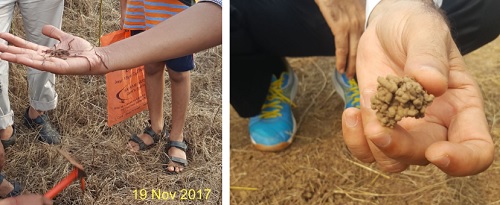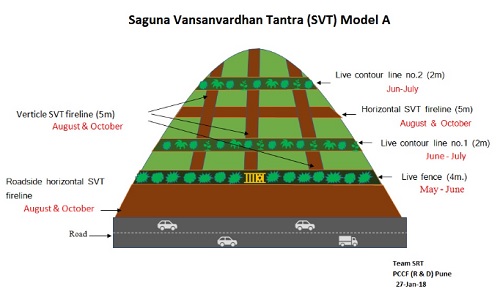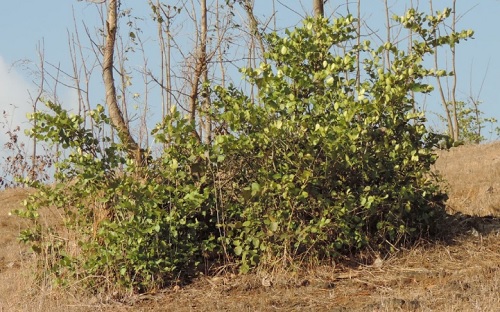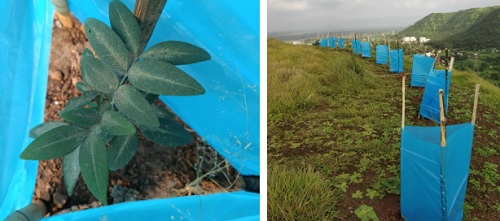Methodology
Forest/wildfires are set on the hills or forests by crooked and selfish people. At the end of the rainy season, the seasonal weeds and grass dies & dries which becomes flammable material & can be lit easily leading to a wild forest fire. This combustible material is lush green in August-September & has 85% water in it. During this time, if this green vegetation dies and gets decomposed in situ, it generates food for earthworms and microorganisms.
Earthworms are one of the most sensitive creatures on the earth and are the best-known soil engineers. The Automatic appearance of earthworms in large numbers due to SVT treatment in a place is as though the Nature God has given 100 out of 100 to the humans in exams. In SVT, the systemic general-purpose weedicide is used to kill and decompose the green grass which converts into 'ready to eat 'food for earthworm and prevents the same from becoming an inflammable material.

"Nature's Approval: Thriving Earthworm Populations Signal; Success of SVT"
Technique 1: Saving the hills and forest from getting totally burnt-out due to Forest Fires-
General-purpose systemic weedicide is to be sprayed on the entire base of the hill and later from the base upwards in horizontal belts. Also, at certain distances spray of vertical belts joining the horizontal belts will be done. The first belt which is at the bottom of the hill, to avoid human intervention, will be the widest at about 20 meters wide and the remaining belts will be 5 meters wide moving toward the top of the hill. The walkways and the demarcation sprays will begin in the 3rd week of June. The final belts will be sprayed approximately in the 3rd week of August when the grass is at the right physiological stage. The second spray will be given approximately the 1st - 2nd week of October.

SVT model for reducing the risk of wildfire without human intervention
Technique 2: Planting and Protection
Plant Selection: Focus on planting species like Karonda (Carissa carandas), Wild Banana (Ensete superbum), and Vetiver grass (Vetiveria zizanioides). These plants are chosen for their resilience, ability to conserve water, and effectiveness in soil erosion prevention.
1. Karonda (Carissa carandas) : It is an evergreen hardy bush with a tuberous root system which has the ability to store ample water in the root system. Perfect plant for rocky slopes which stops soil erosion and becomes an important linkage of the food chain and habitat for forest biodiversity. It also helps slow down the forest fires. Unfortunately the bushes have been chopped off for commercial plantation purposes. The thick green bushes are a unique place of emergence and proliferation of many wild species of plants. The numbers in nature of this important plant have dwindled to a great extent.

"Karonda (Carissa carandas): A Keystone of Forest Ecosystems. This evergreen bush, with its robust tuberous roots, is a natural guardian against soil erosion on rocky slopes and a vital component in forest biodiversity.
2. Wild Banana (Ensete superbum) : It is also called as cliff/rock banana indicating that it survives and performs in the most adverse conditions of hill cliffs and continues to help the ecosystem. Recently the World Bank has stamped this plant as an important World Heritage plant which has an important role in human diets in Africa. The local tribal from Thane and Raigad also use the pseudostem (referred by World Bank) of this plant in their diets. This plant plays a very important role in prevention of soil erosion and retention of moisture in rocky soil of hill slopes. This plant effectively survives through wildfires.

"Resilience in Nature: The Wild Banana (Ensete superbum), a World Heritage plant recognized by the World Bank for its crucial role in the ecosystem. "
3. Vetiver grass (Vetiveria zizanioides) : This perennial grass has the ability to stop soil erosion and water runoff. This also helps water infiltration into sloppy lands. This grass also has the ability to survive through wildfires. A perfect plant for live contour bunding. The vertical deep root system of this plant can hold the soil and store water. Hence the live contour of these plants are useful in bioengineering work for preventing landslides.
As a result, degraded forest areas will experience regeneration, leading to improved biodiversity, soil health, and ecological balance. All the three plant species mentioned above which are very useful in starting the regeneration process on the degraded hills, the major constraint is lack of availability of large quantities of uniform and good quality planting material.

"Vetiver grass for successful Live Contour Bund (LCB) "
It is necessary to think holistically when planting plants to cover the barren hills. For their initial stages of survival and enhancement of their growth and protection from stray cattle and hot-dry summer winds, we have come up with a three-layer plastic cover, the SVT-Sleeve. The inner and outer layer have anti-fogging properties which enables the collecting and trickling of the dewdrops to the root zone of the sapling. And the middle layer being UV resistant prevents scorching of the plant and allows smooth photosynthesis. The sleeve has demonstrated the survival of plants to the tune of 80%, due to which it will be possible to easily increase the survival of the plants planted on the barren hills.

"Revolutionizing Reforestation: The SVT-Sleeve, a three-layered protective marvel, ensuring the survival and thriving of plants on barren hills.
Social Impactful results on the environment and wealth generation
- Carbon Sequestration: In contrast to the carbon emissions from wildfires, a major contributor to global warming, SVT promotes carbon sequestration on the same lands. It's estimated to capture approximately 12 to 15 tons of carbon per hectare annually.
- Biodiversity Enhancement: Within the initial 2-3 years, there's a notable increase in biodiversity. This includes a rise in microorganisms, grasses, honey bees, earthworms, insects, butterflies, reptiles, and birds.
- Improved Plantation Survival Rates: The adoption of SVT has dramatically increased the survival rate of new plantations from nearly zero to 60-70% in the first year.
- Grass Quality and Quantity: There's an almost 100% improvement in both the quality and quantity of grass, benefiting not only wild herbivores but also the livestock of local farmers. Because of the protection of the dry grass on about 150 acres by SVT, it provides livelihood by selling the grass for horses at the hill station to the tribesmen in 3 villages.
- Water Infiltration and Soil Health: The appearance of earthworms in significant numbers in the first year of treatment enhances soil health and water infiltration.
- Alignment with Sustainable Development Goals (SDGs): These positive outcomes align with several of the United Nations' 17 SDGs, particularly Goal 6 (Clean Water), Goal 13 (Climate Action), and Goal 15 (Life on Land), showcasing the industry's commitment to sustainable development.